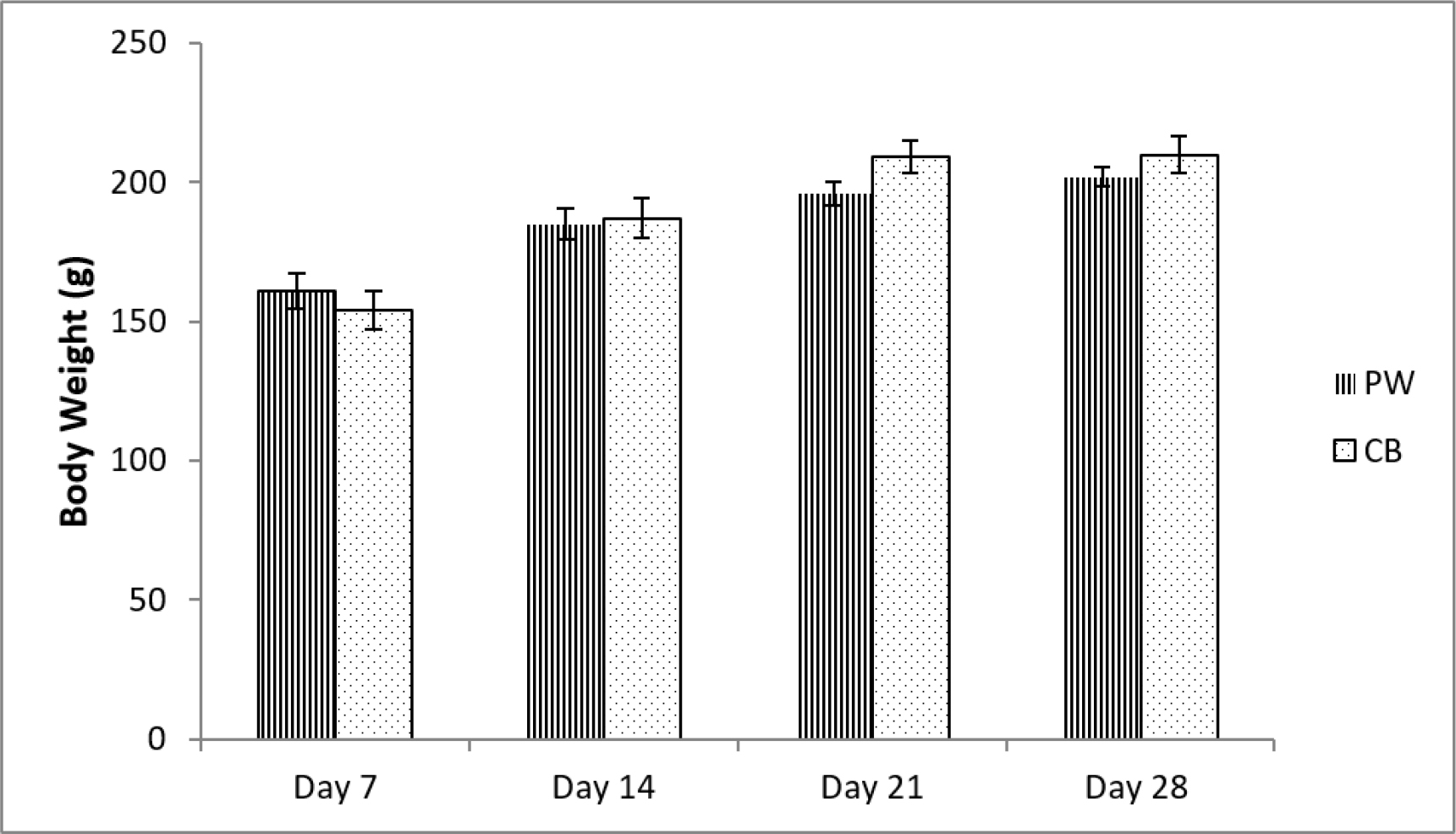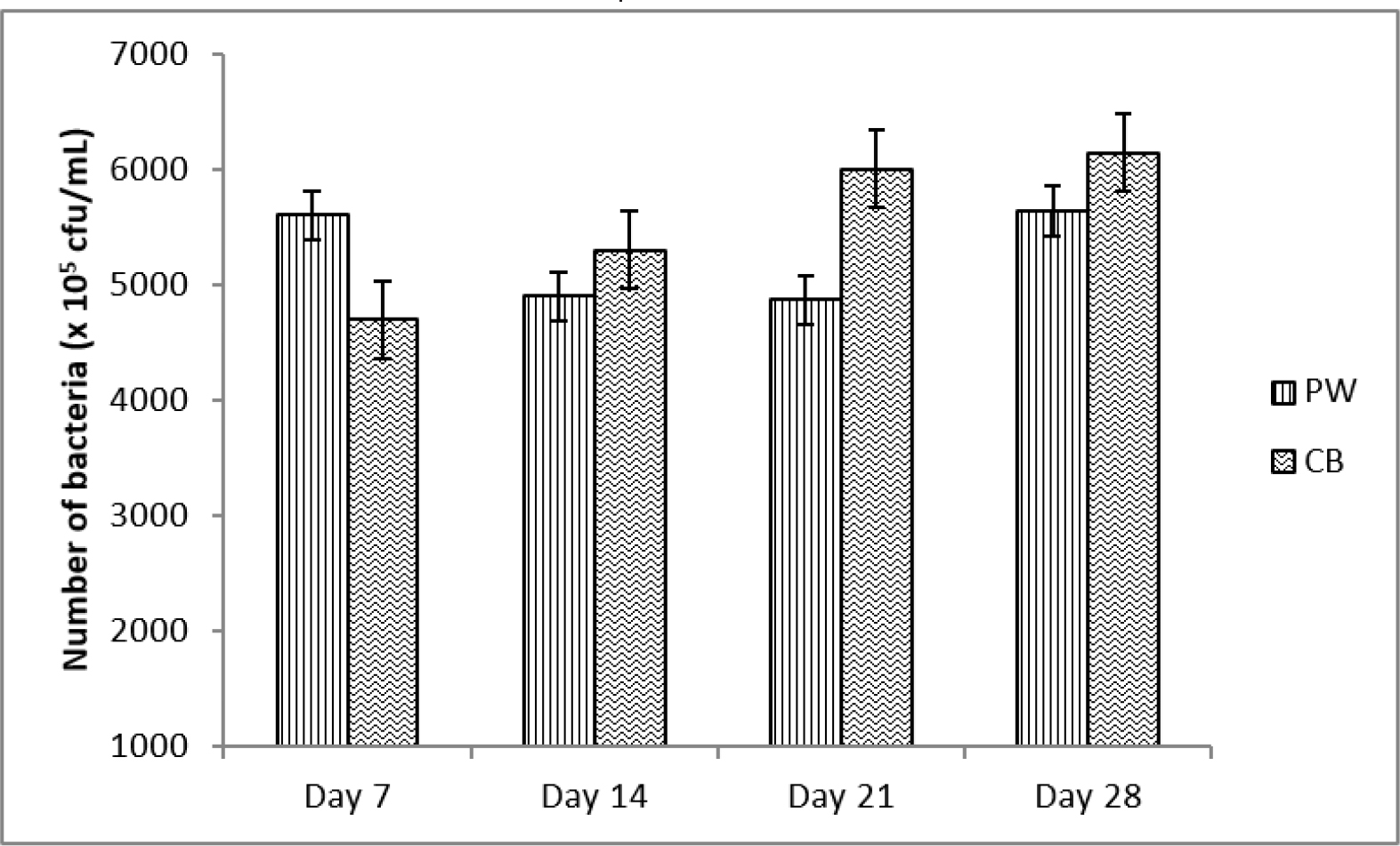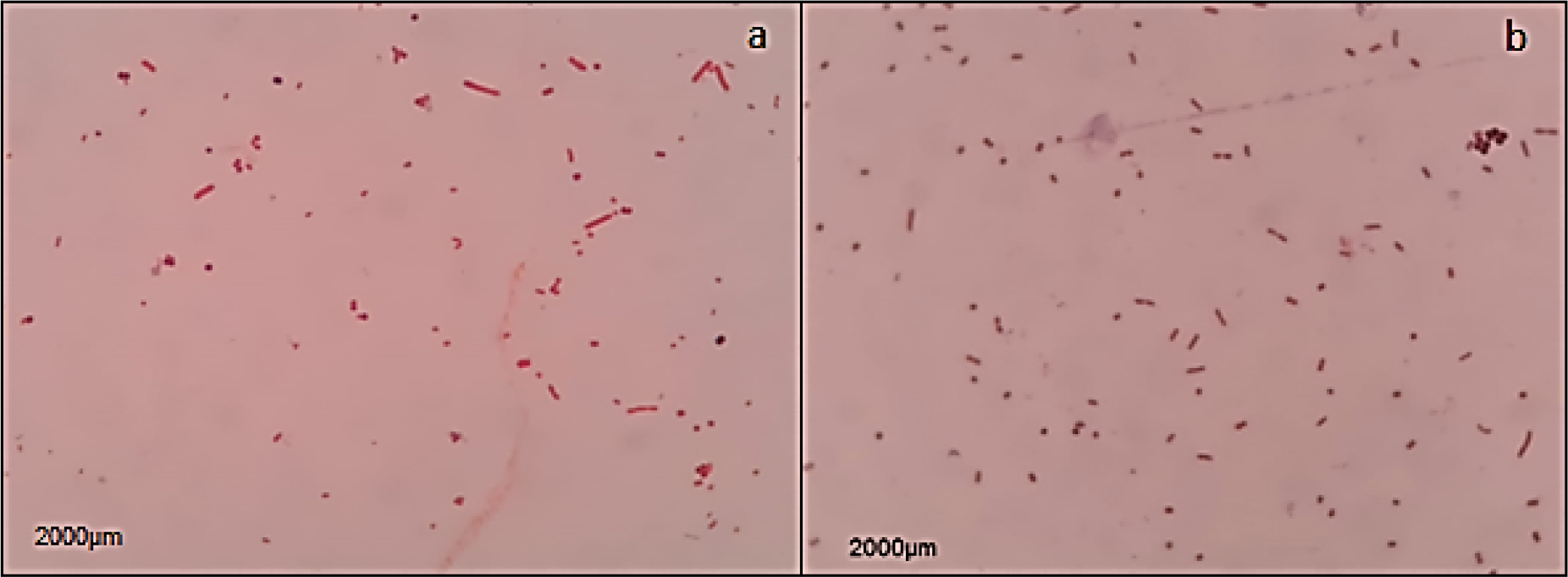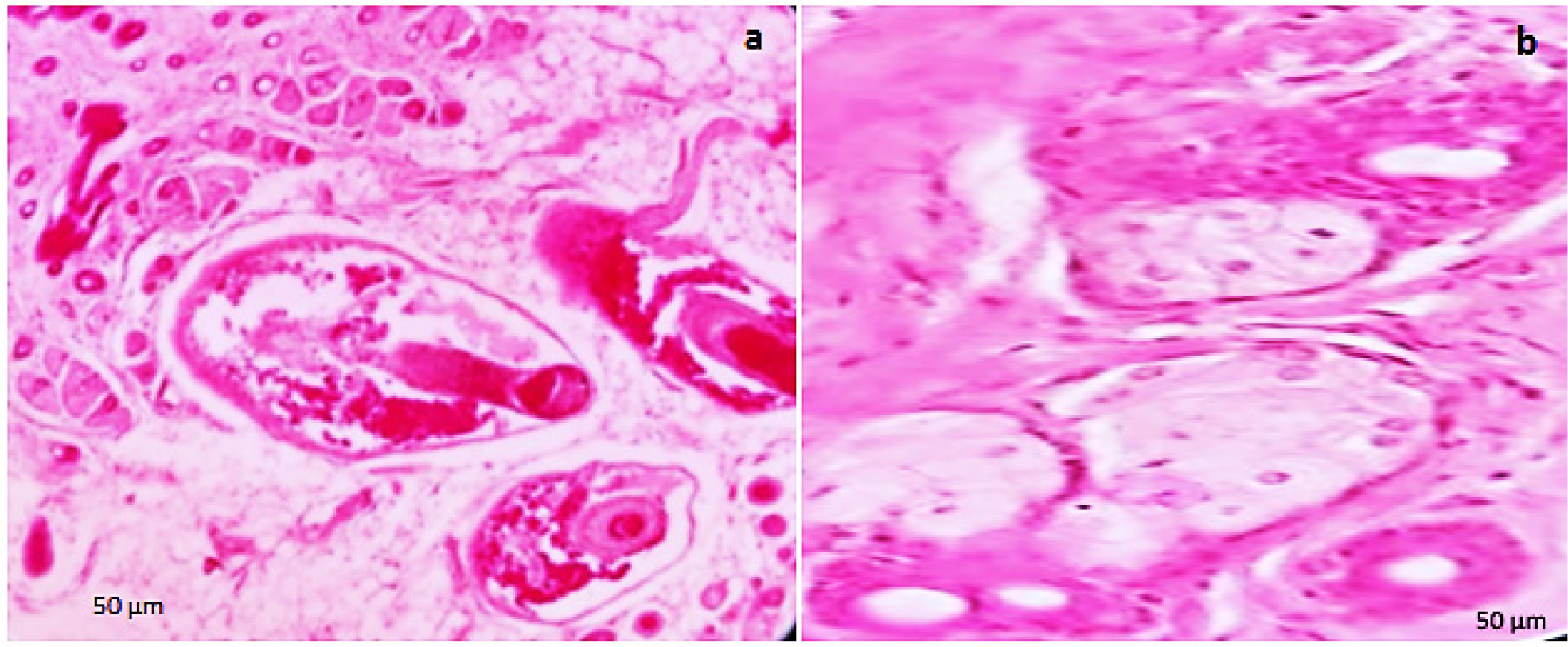ABSTRACT
Background
On average, 20 tree barks are used for the production of animal bedding for Malaysian research universities that carry out animal testing yearly. Even though this figure looks small, sustainable environmental source usage is essential in this era of plant material scarcity. Hence, this research was anticipated for efficient management of pencil waste to be used as animal bedding material. This could reduce the amount of plant lodging for the preparation of bedding material and also efficiently manage pencil waste.
Materials and Methods
In this study, pencil waste material was used as the animal bedding and this bedding material was tested for bacterial count and absorption capability. Furthermore, histopathological analyses of experimental animal paws were performed. The effect of pencil waste bedding on animal body weight and behaviour was also determined.
Results
This present study indicated that pencil waste bedding did not show any significant difference in animal body weight, bacterial count and absorption capability as compared to commercial bedding. In addition, histopathological studies showed that there is no cell necrosis in animal cells.
Conclusion
The current findings of this research concluded that pencil waste material can be efficiently used as animal bedding material to reduce plant lodging and efficiently manage pencil waste produced.
INTRODUCTION
Poor solid waste management has become the main environmental problem in developing countries such as Malaysia. For the past 10 years, the generation of Malaysian solid waste has increased by more than 91% (Agamuthu and Fauziah, 2009; Sariet al., 2012). Therefore, landfill space is exhausted earlier than expected and this causes an imbalance in environmental sustainability and economic growth. Malaysia is experiencing rapid economic development beginning in the late 20th century (Fauziah and Agamuthu, 2004; Anil et al., 2022). However, the waste management system in Malaysia is lacking in its economic growth.
The Earth is experiencing a gradual increase in temperature that leads to global warming and climate change. This temperature increase is primarily due to an increase in atmospheric concentrations of greenhouse gases (Anamet al., 2022; Hritonenko and Yatsenko, 2022). The increase in greenhouse gases is because of CO2 emissions from human activities that include deforestation and fossil fuel consumption (Begumet al., 2020; Jaafaret al., 2020; Raihanet al., 2021a). The significant increase in CO2 emissions is projected to have deleterious effects on the global climate system (Raihan et al., 2019; Begumet al., 2020; Raihanet al., 2022a). Therefore, lowering CO2 emissions and improving environmental quality serves as an essential step to promote sustainable development and prevent climate change (Begum et al., 2015; Raihan and Said, 2021). The demand for plant-based products such as building and furniture manufacturing, paper production, and bedding material preparation causes an increase in deforestation which is a causative factor for global warming. The effective management of pencil waste as animal bedding can decrease the requirement of tree lodging at least for the production of animal bedding.
Bedding influences the duration in which animals remain lying down and, consequently, affects the experimental results (Tucker et al., 2009; Bindet al., 2013). Wood savings made up of fine particles of wood is a preferred bedding material due to its low cost (Burn and Mason, 2004). The current research is anticipated to explore the potential of pencil waste as bedding material as it possesses similar features to commercial bedding which is composed of wood shavings. Hence, this present research compares absorption properties, bacterial growth and histopathological changes of pencil waste with commercial animal bedding to provide evidence of the use of pencil waste as animal bedding.
MATERIALS AND METHODS
Animals
A total of 30 Sprague Dawley rats were used for the experiments includes15 males and 15 females weighing 100 g–150 g. The rats were randomly assigned to a group. The animals were allowed free access to food and water during the experiments, and they were provided with a normal diet.
Bedding Material
The bedding materials were commercial animal bedding (Lagenda Pet Centre, Kedah) and pencil waste material. Animal bedding was placed around 2 cm depth in the cage to allow normal movement of rats. The bedding is changed once a week.
Body weight and behaviour observation
The animals were allowed free access to water and food. Animals’ behaviour were monitored throughout the 28 days of the study period. Any abnormal behaviour such as paw licking or flinching that serves as an indicator of pain was recorded. The body weight of each rat was recorded on days 7, 14, 21 and 28 of the study periods.
Absorption test
The absorption capacity of different types of bedding was evaluated in accordance with Potgieter and Wilke., 1996; Fatih et al., 2017. 50 cm3 of commercial rat bedding and pencil waste was weighed followed by placing it into a glass beaker. Next, beakers were shaken gently to release any air bubbles trapped before soaking them for one hour. After one hour, the water was poured away, and a small sieve was used to collect the wet bedding. Finally, the bedding was weighed, and the absorption capacity was calculated by using the formula: (Potgieter and Wilke, 1996; Fatih et al., 2017).
Absorption capacity (%) = (A-B/B)×100
A=Mass after water absorption.
B=Initial Mass.
Microbiological analysis using spread plate
Microbiological analysis was performed through spread plate method (Maturin and Peeler 2001) in which samples were randomly taken from each cage on day 7, 14, 21 and 28. Samples that consist of 1 g of bedding material were homogenised with 100 mL of distilled water. The homogenised bedding materials were subjected to serial dilution using a sterile saline. 0.1 mL from each dilution was spread onto nutrient agar for the total bacterial count. Finally, plates were incubated at 37ºC for 24 hr and the microbial growths were observed on the following day.
Microbiological analysis using gram staining procedure
A gram staining procedure was performed to identify the type of bacteria present in the different bedding samples. Firstly, the slide containing the smear was added with 3-5 drops of crystal violet stain for 1-2 min. Then, 3-5 drops of Gram’s iodine solution were added after rinsing it with tap water. The stain was decolourized by letting the alcohol run down over the slide for 10 sec. Thereafter, the slide was quickly rinsed with water. Then, 3 drops of counterstain safranin were added, and the stain was left for 60 sec. Finally, the slide was rinsed with tap water and was air-dried before examining the slide under the oil immersion lens.
Histopathological analysis
On the day 28th, the footpad skins of rats in each group were removed and fixed in 10% formalin. After dehydration in a graded ethanol series and cleaning with xylene, the sample material was embedded in paraffin. Subsequently, 4 μm-thick sections of samples were stained with Haematoxylin-Eosin (HE) for observation under a light microscope. Tissue sections were observed by a high-power light microscopic examination using an Olympus Bx51 with a DP72 camera (Olympus America Inc., Center Valley, PA, USA) system. Ten microscopic fields were randomly examined at 20x magnification. Pathological changes of rat’s samples placed in cage with pencil waste bedding were compared with rats sample placed in cage with commercial bedding.
Analyses
One-way Analyses of Variance (ANOVA) were used for comparison of different beddings. Statistical analyses were carried out using IBM SPSS Statistics for Windows (Version 20, IBM). Differences were considered significant at p<0.05 and differences among groups were analyzed using Tukey’s multiple comparison post hoc test at p<0.05.
RESULTS
Bedding material effect on animal behaviour and lifespan
The pencil waste bedding material used shows no effect on animal behaviour and lifespan. No abnormal behavior such as paw licking or flinching noticed. There was no mortality recorded until the end of the study period.
Bedding material effects on body weight
Pencil waste bedding material had no significant effect (p>0.05) on body weight as compared to commercial bedding (Figure 1). Throughout the 28-day experimental period, rats in both groups showed normal growth patterns and behaviours with no significant differences in weight gain.

Figure 1:
Body weight differences in rats using different types of bedding material on day 7, 14, 21 and 28; PW: pencil waste, CB: Commercial Bedding. Data shown are mean±SEM. Not significant (p>0.05, one-way Analysis of Variance [ANOVA] and Tukey’s multiple comparison test; n=5).
Absorption percentage
There is no significant difference at p>0.05 for absorption properties of commercial bedding and pencil waste (Figure 2). Both materials demonstrated comparable capacity to absorb moisture and liquid waste which indicates that pencil waste is equally effective in maintaining a hygienic and dry cage environment.

Figure 2:
Absorption percentage (%) of different bedding material on day 7, 14, 21 and 28; PW: pencil waste, CB: Commercial Bedding. Data shown are mean±SEM. Not significant (p>0.05, one-way Analysis of Variance [ANOVA] and Tukey’s multiple comparison test; n=5).
Microbial count
Microbial count indicates that there is no significant difference in number of bacterial species in pencil waste bedding as compared to commercial bedding on day 7, 14, 21 and 28 of the study (Figure 3).

Figure 3:
Bacterial count from each cage on day 7, 14, 21 and 28 of the study. Data was presented as mean±SEM (n=5). Not significant (p>0.05, one-way Analysis of Variance [ANOVA] and Tukey’s test; n=5).
Microbiological analysis using gram staining
Microbiological analysis using gram staining indicates the presence of both gram-positive and gram-negative bacteria in both pencil waste and commercial bedding. There are no significant differences in the number of microbial species presence in pencil waste animal bedding as compared to commercial animal bedding (Figure 4).

Figure 4:
Gram staining for (a) pencil waste bedding (b) commercial bedding with a 20x magnification using a light microscope.
Histopathological analysis
Histopathological analysis showed that there are no morphological changes in the extracellular matrix and cytoplasm of animal paws of animal in commercial and pencil waste bedding. No degenerative changes and acantholysis were observed in epithelial cells (Figure 5).

Figure 5:
Hematoxylin and Eosin staining (20x magnification) for animal paw with (a) pencil waste and (b) commercial bedding.
DISCUSSION
Bedding material, which serves as an essential component of rodent housing, has a significant effect on the well-being and health of laboratory animals (Burnet al., 2006). Animal bedding is important for moisture absorbance from faeces and urine (Hawkins et al., 2003). Maintaining hygiene in rodent cages is necessary to keep animals healthy and slow down bacterial growth. Rat bedding material is composed of wood (Fatih et al., 2017). Wood shavings are used commercially due to their high absorbency, and it is cost-effective. A recent study published estimates that 15.3 billion trees are chopped down every year for paper production, building manufacturing, furniture production, bedding material preparation and other uses (Ichimuraet al., 2009). Hence, a vital step is required to reduce the tree lodging.
The current research was anticipated to reduce tree lodging for animal bedding preparation by using pencil waste material as animal bedding. Pencil shaving wastes, used in our daily lives, are always discarded as daily waste (Lewis and Demmers, 2013; Mayuret al, 2022). Inspired by their composition of wood as similar to the composition of commercial bedding, this research was conducted to efficiently manage waste and reduce wood extraction for the production of animal bedding.
The current results demonstrate that pencil waste bedding had no significant effect (p>0.05) on the body weight of rats throughout the study period (Anand Babu and Prasad, 2014; Burnet al., 2006). Thus, pencil waste can be used widely as bedding material without affecting animal body weight. This study also revealed that there is no significant difference (p>0.05) in absorption properties between commercial bedding and pencil waste. Absorption capacity remains an important characteristic of animal bedding to control ammonia production and bacterial growth (Burn and Mason, 2004; Pramod Saharan, 2018). In this study, the total bacterial count indicates that there is no difference in terms of bacterial colony for animals placed in cages with commercial bedding or pencil waste. Some bedding materials with low absorption capacity may not provide sufficient urine absorption and this may cause an increase in bacterial growth that can lead to animal infection or mortality (Ferrechia et al., 2014). In this present study, there are no infectious symptoms observed in rats, such as sneezing, sniffling, weight loss or discharge release from the eyes or nose. In addition, there is no mortality recorded until the end of the study period indicating that there is no bacterial infection. The bacterial presence in the samples of animal bedding might be due to animal faeces and urine (Domeret al., 2012). Microbiological analysis indicates the presence of both gram-positive and gram-negative bacteria in the samples of animal bedding. The possible common gram-positive and gram-negative bacteria present in animal faeces and urine might be S. aureus, B. cereus, E. faecalis, P. aeruginosa or E. coli (Moonet al., 2022; Hammerum and Heuer, 2009). Some researchers have reported that certain animal bedding can cause dermatitis and irritant effects (Xavieret al., 2010). Hence, the use of pencil waste as bedding material is safe without causing any skin disorder, weight loss and mortality. Histopathological analysis showed that there are no degenerative changes and acantholysis observed in the epithelial cells of the animal paw. Literature has indicated that the use of certain types of animal bedding is related to degenerative and inflammatory skin reactions (Fatih et al., 2017; Mondal et al., 2018).
Pencil waste consists of zinc, copper, graphite and pumice. Graphite is a nonpoisonous substance that is approved for use in food and pharmaceutical applications such as ovens, dryers and food conveyors. The use of pencil waste–derived materials for solar-power generation has been reported, however yet there is no publication on the usage of pencil waste as animal bedding (Luet al., 2020; Sanket and Aby; 2019). In the animal hygiene aspect, bedding material is an important constituent of animal wellness and comfort that is closely related to reliable results in experimental research (Raset al., 2002). Frequent cage changes every week have demonstrated an effect on the behaviour, health and stress of animals (Burn and Mason, 2008; Van Looet al., 2004). Pencil waste used as animal bedding permits regular bedding changing without any cost. Based on their utility, lead pencils are commonly used in schools and offices but are often discarded after only partial use. Although pencils are inexpensive, the waste they generate holds potential for use in energy devices and as recyclable material (Nawazet al., 2022; Basuki, 2015; Adebayo and Obiekezie., 2018). This current research explores the potential of pencil waste to be used as animal bedding that can serve as an efficient pencil waste management strategy.
CONCLUSION
The current research discover that the use of pencil waste as bedding material of animal is safe. Hence pencil waste material can be used as animal bedding material to reduce plant lodging and efficiently manage waste produced.
Cite this article:
Fazlina M, Sahgal G, Varatharajan R, Yamunna P, Ameerdin MA, et al. Sustainable Management of Pencil Waste through Conversion to Rat Bedding. J Young Pharm. 2025;17(3):537-42.
ACKNOWLEDGEMENT
We would like to acknowledge the principal and teachers (Puan Hafizoh and Puan Shuhaida) of Sekolah Kebangsaan Seri Gemilang, Butterworth, Penang, Malaysia for their cooperation in collecting and providing pencil waste to be used as animal bedding.
References
- Adebayo F. O., Obiekezie S. O.. (2018) Microorganisms in waste management. Research Journal of Science and Technology 10: 28-39 https://doi.org/10.5958/2349-2988.2018.00005.0 | Google Scholar
- Agarwal A. K., Yadav A., Yadav C. S., Mahore R., Singh A. P.. (2022) A study of awareness about biomedical waste management among health care personnel. Asian Journal of Management 13: 171-175 https://doi.org/10.52711/2321-5763.2022.00031 | Google Scholar
- Anam M. Z., Bari A. B. M. M., Paul S. K., Ali S. M., Kabir G.. (2022) Modelling the drivers of solar energy development in an emerging economy: Implications for sustainable development goals. Resources, Conservation & Recycling Advances 13: Article 200068 https://doi.org/10.1016/j.rcradv.2022.200068 | Google Scholar
- Anand B., Prasad M. C.. (2014) Evaluation of micro environment and microbiological monitoring of various bedding material for laboratory rodents. Evaluation 1 https://doi.org/10.1016/j.rcradv.2022.200068 | Google Scholar
- Basuki B.. (2015) Eco-efficiency and sustainable development as efforts to produce environmentally friendly product: An exploratory case study. Issues in Social and Environmental Accounting 9: 199-218 https://doi.org/10.22164/isea.v9i3.105 | Google Scholar
- Begum R. A., Raihan A., Said M. N. M.. (2020) Dynamic impacts of economic growth and forested area on carbon dioxide emissions in Malaysia. Sustainability 12: 9375 https://doi.org/10.3390/su12229375 | Google Scholar
- Bind R. H., Minney S. M., Rosenfeld S., Hallock R. M.. (2013) The role of pheromonal responses in rodent behavior: Future directions for the development of laboratory protocols. Journal of the American Association for Laboratory Animal Science 52: 124-129 https://doi.org/10.3390/su12229375 | Google Scholar
- Burn C. C., Mason G. J.. (2005) Absorbencies of six different rodent beddings: Commercially advertised absorbencies are potentially misleading. Laboratory Animals 39: 68-74 https://doi.org/10.1258/0023677052886592 | Google Scholar
- Burn C. C., Mason G. J.. (2008) Effects of cage-cleaning frequency on laboratory rat reproduction, cannibalism, and welfare. Applied Animal Behaviour Science 114: 235-247 https://doi.org/10.1016/j.applanim.2008.02.005 | Google Scholar
- Burn C. C., Peters A., Day M. J., Mason G. J.. (2006) Long-term effects of cage-cleaning frequency and bedding type on laboratory rat health, welfare, and handleability: A cross-laboratory study. Laboratory Animals 40: 353-370 https://doi.org/10.1258/002367706778476460 | Google Scholar
- Domer D. A., Erickson R. L., Petty J. M., Bergdall V. K., Hickman-Davis J. M.. (2012) Processing and treatment of corncob bedding affects cage-change frequency for C57BL/6 mice. Journal of the American Association for Laboratory Animal Science 51: 162-169 https://doi.org/10.1258/002367706778476460 | Google Scholar
- Fauziah S. H., Simon C., Agamuthu P.. (2004) Municipal solid waste management in Malaysia-possibility of improvement?. Malaysian Journal of Science 23: 61-70 https://doi.org/10.1258/002367706778476460 | Google Scholar
- Ferrecchia C. E., Jensen K., Van Andel R.. (2014) Intracage ammonia levels in static and individually ventilated cages housing C57BL/6 mice on 4 bedding substrates. Journal of the American Association for Laboratory Animal Science 53: 146-151 https://doi.org/10.1258/002367706778476460 | Google Scholar
- Hammerum A. M., Heuer O. E.. (2009) Human health hazards from antimicrobial-resistant of animal origin. Clinical Infectious Diseases 48: 916-921 https://doi.org/10.1086/597292 | Google Scholar
- Hritonenko V., Yatsenko Y.. (2022) Sustainable adaptation and mitigation in regions and cities: Review of decision-support methods. Resources, Conservation & Recycling Advances 13: Article 200066 https://doi.org/10.1016/j.rcradv.2022.200066 | Google Scholar
- Ichimura M., Nam S., Bonjour S., Rankine H., Carisma B., Qiu Y., Khrueachotikul R., et al. (2009) Measuring resource-use efficiency and the impact of economic activities. https://doi.org/10.1016/j.rcradv.2022.200066 | Google Scholar
- Jaafar W. S. W. M., Maulud K. N. A., Kamarulzaman A. M. M., Raihan A., Sah S. M., Ahmad A., Saad S. N. M., Azmi A. T. M., Syukri N. K. A. J., Khan W. R., et al. (2020) The influence of forest degradation on land surface temperature-A case study of Perak and Kedah, Malaysia. Forests 11: 670 https://doi.org/10.3390/f11060670 | Google Scholar
- Lewis H., Demmers M.. (2013) Life cycle assessment and environmental. Australasian Journal of Environmental : 110-123 https://doi.org/10.3390/f11060670 | Google Scholar
- Lu Y., Dai T., Fan D., Min H., Ding S., Yang X., et al. (2020) Turning trash into treasure: Pencil waste-derived materials for solar-powered water evaporation. Energy Technology 8: 1-9 https://doi.org/10.1002/ente.202000567 | Google Scholar
- Ramkrishna M., Satyanarayana P.. (2018) Knowledge, attitude and practice (KAP) study regarding bio-medical waste management among staff in a tertiary care hospital at Andhra Pradesh. Asian Journal of Management 9: 267-271 https://doi.org/10.5958/2321-5763.2018.00040.9 | Google Scholar
- Mayur B., Someshwar M., Pratik M., Sayli C.. (2022) Overall review on current scenario in waste management system. Asian Journal of Management 13: 200-208 https://doi.org/10.5958/2321-5763.2018.00040.9 | Google Scholar
- Moon D.-C., Choi J.-H., Boby N., Kang H.-Y., Kim S.-J., Song H.-J., Park H.-S., Gil M.-C., Yoon S.-S., Lim S.-K., et al. (2022) Bacterial prevalence in skin, urine, diarrheal stool, and respiratory samples from dogs. Microorganisms 10: 1668 https://doi.org/10.3390/microorganisms10081668 | Google Scholar
- Nawaz A., Sarwar N., Jeong D. I., Yoon D. H.. (2022) Energy from discarded graphite-based pencils: Recycling the potential waste material for sensing application. Sensors and Actuators A 336: 1-6 https://doi.org/10.1016/j.sna.2022.113403 | Google Scholar
- Saharan P.. (2018) Biomedical waste management rules-2016: An update on recent evidence in Indian scenario. Asian Journal of Nursing Education and Research 8: 304-306 https://doi.org/10.5958/2349-2996.2018.00060.5 | Google Scholar
- Periathamby A., Hamid F. S., Khidzir K.. (2009) Evolution of solid waste management in Malaysia: Impacts and implications of the Solid Waste Bill 2007. Journal of Material Cycles and Waste Management 11: 96-103 https://doi.org/10.1007/s10163-008-0231-3 | Google Scholar
- Potgieter F. J., Wilke P. I.. (1996) The dust content, dust generation, ammonia production, and absorption properties of three different rodent bedding types. Laboratory Animals 30: 79-87 https://doi.org/10.1258/002367796780744893 | Google Scholar
- Raihan A., Ara Begum R., Mohd Said M. N.. (2021a) A meta-analysis of the economic value of forest carbon stock. Malaysian Journal of Society and Space 17: 321-338 https://doi.org/10.17576/geo-2021-1704-22 | Google Scholar
- Raihan A., Begum R. A., Nizam M., Said M., Pereira J. J.. (2022a) Dynamic impacts of energy use, agricultural land expansion, and deforestation on CO2 emissions in Malaysia. Environmental and Ecological Statistics 29: 477-507 https://doi.org/10.1007/s10651-022-00532-9 | Google Scholar
- Raihan A., Said M. N. M.. (2021) Cost-benefit analysis of climate change mitigation measures in the forestry sector of peninsular Malaysia. Earth Systems and Environment 6: 1-15 https://doi.org/10.1007/s41748-021-00241-6 | Google Scholar
- Ras T., Van de Ven M., Patterson-Kane E. G., Nelson K.. (2002) Rats preferences for corn- versus wood-based bedding and nesting materials. Laboratory Animals 36: 420-425 https://doi.org/10.1258/002367702320389080 | Google Scholar
- Sari D. P., Hartini S., Rinawati D. I., Wicaksono T. S.. (2012) Pengukuran tingkat eko-efisiensi menggunakan life cycle assessment untuk menciptakan sustainable production di industri kecil menengah batik. Jurnal Teknik Industri 14: 137-144 https://doi.org/10.1258/002367702320389080 | Google Scholar
- Shettennavar S., Vithayathil A.. (2019) Exploratory study of biomedical waste management-An IoT perspective. Asian Journal of Management 10: 181-189 https://doi.org/10.5958/2321-5763.2019.00029.5 | Google Scholar
- Van Loo P. L., Van der Meer E., Kruitwagen C. L., Koolhaas J. M., Van Zutphen L. F., Baumans V., et al. (2004) Long-term effects of husbandry procedures on stress-related parameters in male mice of 2 strains. Laboratory Animals 38: 169-177 https://doi.org/10.1258/002367704322968858 | Google Scholar
- Xavier D. B., Broom D. M., McManus C. M. P., Torres C., Bernal F. E. M.. (2010) Number of flocks on the same litter and carcass condemnations due to cellulitis, arthritis and contact food pad dermatitis in broilers. British Poultry Science 58: 6 https://doi.org/10.1258/002367704322968858 | Google Scholar
- Yildirim F., Yildirim B. A., Yildiz A., Kapakin Terim K. A., Cengiz S., Özdemir S., et al. (2017) Evaluation of perlite, wood shavings and corncobs for bedding material in rats. Journal of the South African Veterinary Association 88: e1-e7 https://doi.org/10.4102/jsava.v88i0.1492 | Google Scholar
